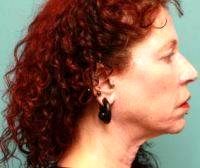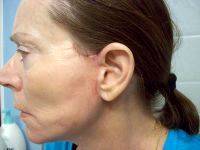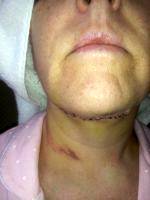Pulled Look After Facelift
The pulled look happens when the underlying muscle and fat is not addressed.
The only way to avoid a pulled look is to go to a qualified surgeon, board certified in plastic surgery that specializes in facelifts.
He or She should have experience with the type of problem you are presenting.
Someone specialized will address the underlying anatomy instead of just pulling the skin. (Vivian Hernandez, MD, FACS, Boca Raton Plastic Surgeon)
The “pulled up” look results from one of a few misguided ideas:

A Tight Or Pulled Look After A Facelift
- Trying to avoid surgery in the neck by pulling up hard on the sides of the face to make the neck look better. The best way to avoid this look is to treat the neck thoroughly through a hidden chin incision, then lift the sides of the face conservatively
- Trying to “stretch out” wrinkles or the nasolabial folds/marionette lines. Folds deserve to be filled, and wrinkles resurfaced. Trying to pull face skin to undo these lines is a losing battle – temporary improvement, but permanent “pulled/stretched” face.
- Trying to “lift” the upper cheek rather than filling it (with fat or an implant). The single biggest determining factor in excellent face/necklift results is not the technique used – it is the surgeon’s artistic vision and understanding of what really works for each facial structure. (Laxmeesh Mike Nayak, MD, Saint Louis Facial Plastic Surgeon)
Make sure to choose your Facelift surgeon carefully
There are many different techniques for face lift surgery, and each utilizes a technique to “pull up” the underlying tissues as well as remove extra skin. If you want to have a more natural look, the underlying pull should be in a vertical direction to correct sagging from gravity and time.

Adding Micro- Fat Grafts Or Fillers Where The Tissue Is Deficient
Depending on how much skin also needs to be removed, you may also benefit from one of the “short scar” approaches. The bottom line is to choose a cosmetic surgeon who has significant experience in facial cosmetic surgery, and then together choose the best approach for your particular situation. (Michael H. Rosenberg, MD, Mount Kisco Plastic Surgeon)
Choose a good surgeon
Outcomes are dependent on the surgeon. I do a composite technique that does not employ the skin to support the lift. Therefore, the skin is sutured under no tension. It is not the only technique, but someone skilled at the operation can give very good and very natural appearing results. (Vincent N. Zubowicz, MD, Atlanta Plastic Surgeon)
A proper analysis preop will prevent the windswept look
The windswept look occurs typically in patients with thin faces and varying degrees of bone and fat atrophy. When they get the muscle and skin lifted, there in no volume to shape around and they end up looking flat and pulled.

Avoiding The Pulled Or Overdone Look
If you have a rounder, more full face, than you will have minimal risk of getting the pulled look. But if you have a thin, gaunt face, you will need some volumization in addition to the lift.
I like using a patient’s own fat to fill up areas of deflation. I also like using facial implants if there are issue of bony loss that come with the aging process. Make sure you surgeon routinely operates on faces so that your results may be optimized. (Manish H. Shah, MD, FACS, Denver Plastic Surgeon)
How not to get a pulled up look after a facelift
Every plastic surgery should have an armony with the rest of the body. Therefore, you must look for a certified plastic surgeon, extremely skilled in the face. The goal for a facelift is to end up with a very natural refreshed look.
That is why personally operated my moms face. The plastic surgeon surgeon must be a very detailed guy, If he is an OCD, that is much better. (Alberto Arguello, MD, Costa Rica Plastic Surgeon)

Board Certified Plastic Surgeon Should Not Result In A Pulled Look
Avoid the windswept facelift by supporting underlying structures
A pulled or windswept look after a facelift is usually the result of putting too much tension on the skin and not tightening the underlying structures (fat and muscle). Particularly if the facelift takes only an hour or two, this is probably because just the skin is tightened.
I take almost that long just to close the incisions to avoid unnecessary scarring! (Jonathan Hoenig, MD, Beverly Hills Oculoplastic Surgeon)
Avoiding the pulled look with facelift
A pulled look is produced when the skin is pulled tight in order to smooth out the face. This most often occurs when patients demand a mini-facelift since the only thing being done is pulling on the skin.
In a traditional facelift, the skin is elevated and the underlying tissue is elevated in a superior or oblique vector (direction), the skin is then gently placed back in place over the rejuvenated facial structures. This is what would give the most natural look. (David Shafer, MD, New York Plastic Surgeon)

Board-certified Cosmetic Plastic Surgeon Give You A Natural Look
Avoiding the wind swept look after a facelift
Avoiding the wind swept look after a facelift is easily accomplished by not having it done in the first place. What I mean by that is when seeking a facelift, ask the surgeon to make sure that you are not overpulled.
The only advantage of overpulling is to avoid the inevitable relaxation that occurs within the first year of the procedure.
I advise my patients to have a more natural look by gently lifting the tissues to their more normal positions and remove a conservative amount of skin to avoid the wind tunnel effect.
They are advised that a touch-up procedure might be necessary as the skin relaxes. This in my opinion is better than having an over pulled look. (Scott Trimas, MD, Jacksonville Facial Plastic Surgeon)

Combination Of Repositioning And Removing The Lax Excess Tissue
Different surgeons have different aesthetic eyes. The only way to really determine what kind of outcome you can expect is to look at the results of the surgeon. Most surgeons do surgery the same way each time and therefore their results tend to be consistent. (Christopher L. Hess, MD, Fairfax Plastic Surgeon)
Avoiding The Pulled, Windswept Face Lift
The key to avoiding a windswept pulled face lift is to do a multi-layer face lift and choose an experienced plastic surgeon that performs an individual approach to facial rejuvenation and respect the patient’s inherent facial structures and asymmetries and restore them to a more youthful state based upon concise facial analysis.
Facial aging is very scientifically pre-determined. Face lift techniques must be designed to restore natural beauty and youthfulness without violating anti-aging axioms such as excess pulling with a single layer face lift or minimal lifting in the incorrect vector gives you that “windswept and pulled look” and detracts from a patient’s normal aesthetic appearance.

Looking Too Pulled
Therefore, choose your surgeon wisely based upon the experience and expertise and make sure you look at the plastic surgeon’s facelift photo gallery to see what the long-term results are. (Rod J. Rohrich, MD, Dallas Plastic Surgeon)
Facelifts should look Natural
The windswept look is often a result of bad facelift surgery. Your surgeon should listen to what you would like to achieve. I have pioneered a new type of face lift called Concept Facelift. It is performed under local anaesthetic and addresses the lower face including the jowls.
As it is done under local anaesthetic the recovery is much quicker and more appealing. My concept is very much like a traditional facelift but I use absorbable stitches, there are no drains or bandages afterwards and unlike other Local anaesthetic facelifts I work on the muscle as well as the skin which gives much better results which last between 7-10 years.

Most Patients Want To Look Natural
My results are very natural and some people do not tell their friends and family that they have had this procedure! (Amir Nakhdjevani, MBBS, MRCS, FRCS (Plast), London Plastic Surgeon)
Wind swept look after a facelift
Facial cosmetic surgeries are always customised based on the patients concerns & expectations following surgery. The outcome is planned based on the existing features and anatomical landmarks on the face. Therefore, the “wind swept” appearance can best be avoided by clearly outlining & establishing realistic expectations pre op, during your consult with a board certified plastic surgeon.
You would need to emphasise on the fact, that you DO NOT want to seem “overdone”. (Sameer Karkhanis, MS, DNB, India Plastic Surgeon)
Avoid the “pulled up” look from a facelift
This type of result can be avoided by a skilled, experienced, board certified and reputable facial plastic surgeon. Your surgeon will discuss what kind of results you can expect as well as the kind of results he/she can deliver. (Vu Ho, MD, Plano Facial Plastic Surgeon)

Problems With Recovery After Face Lift
Choose a surgeon with the right aesthetic vision
You’re not alone. As a double board-certified plastic surgeon who specializes in facelifts, I can assure you that avoiding the “windswept” look is a primary concern for most of my patients. The good news is that this can be easily avoided if you’re working with the right plastic surgeon.
First, be sure you are working with someone who is truly a “board-certified plastic surgeon,” because this requires specialized training and rigorous testing. Doctors can claim to be cosmetic surgeons even if they haven’t had direct training in plastic surgery, so look up their credentials.
Second, be sure to look over the surgeon’s before-and-after photos for facelifts and look for testimonials and feedback from other patients. Just as you may have a different fashion sense than a friend, surgeons can have different aesthetic judgements and opinions of what looks best, so find a surgeon who favors the more natural-looking result you want.

The Excess Skin Is Pulled Up And Back
Finally, during your consultation, be very clear about the results you’re looking for and about all of your concerns, and make sure your expectations are realistic. Keep in mind that there are also different types of facelifts.
Most of my patients (especially those who want to look particularly natural) opt for my Band Aid Mini Facelift, which is a minimally invasive surgery performed in-office under local anesthesia. This procedure focuses on maintaining a natural look and avoiding the extensive recovery time, scarring, bruising, and swelling of a traditional facelift. (John L. LeRoy, MD, FACS, Atlanta Plastic Surgeon)
Patients who have not undergone previous poorly done plastic surgery and have reasonable skin elasticity should not get a “windswept” look from their facelift. The key word is that the surgery needs to be performed by a skilled surgeon who will do a complete and thorough job without excess pulling of the skin.

The Facelift Windswept Look
Ask to review many before and after photos of other patients of your surgeon to have a sense of confidence. (Jon A. Perlman, MD, Beverly Hills Plastic Surgeon)
It is difficult to know exactly what you are referring to without an example, as there is a spectrum of suboptimal results which all may be described as being ‘pulled up.’ As a general truism, your first operation will be its best and have the most dramatic changes and the most natural results.
As re-do procedures occur, the results tend to be less dramatic and have a more ‘unnatural’ or ‘pulled up’ result, as tightening and re-tightening tissue tends to result in diminishing returns. (Bryan Correa, MD, Houston Plastic Surgeon)
How to avoid windswept face
The simple answer to this question is to choose your surgeon carefully. Your surgeon must be experienced in all types of facial rejuvenation surgery and must have gone through and detailed history and examination before suggesting any particular line of treatment.

The Skill And Judgment Of The Surgeon Is The Most Critical Of All Elements
Different faces are suited to different facial rejuvenation techniques and there is no one answer to all problems. Make sure you have checked out your surgeons qualifications, have discussed your treatment on multiple occasions and feel relaxed and confident in your surgeons presence. (James Murphy, FRCS(Plast), Manchester Plastic Surgeon)
A wind swept or pulled look is a telltale sign of a facelift procedure. A properly performed facelift should leave the patient looking natural and refreshed.
The keys to facelift surgery involve treating sagging tissues by re-elevating them. The so-called skin only facelift attempts to pull the skin tight so that it supports the underlying sagging tissues. This is not treating the problem at its origin.
This can leave patients looking “pulled” because the tension in the skin that is required is too much for a natural appearance. This increased tension can also lead to widened scars. Facelift techniques vary, but I prefer the extended SMAS procedure.

Why Do So Many People Have An Over-pulled Look After Facelift Surgery
The SMAS is a deep connective tissue layer that covers the entire face and is continuous with the platysma muscle in the neck. After the skin is elevated, the SMAS is carefully freed from the underlying tissues.
It is re-elevated and secured in a higher position. This has the effect of the elevating descended tissues, increasing fullness of the cheekbone area, softening the nasolabial fold, improving the jowls, and restoring full jawline.
Importantly, the tissue re-elevation has been performed without any tension on the skin.
The skin of the face is then re-draped, trimmed, and the incision is sewn without any tension. This tensionless skin closure prevents the pulled look.
A properly performed facelift will give a very natural appearance. (Austin Hayes, MD, Portland Plastic Surgeon)

Face To Look Like You’re In A Wind Tunnel
A properly performed facelift will not give you a windswept look. Th key is to target the structural foundation of the face, rather than just the skin. (Jerome Edelstein, MD, Toronto Plastic Surgeon)
Make sure you discuss with your surgeon the technique he is planning to use in your surgery. Any technique that completely relies on tightening the skin only without releasing the restraining ligaments of the face or without tightening the deeper layers of the face can lead to results that look done and unnaturally tight. (Mohammed Alghoul, MD, Chicago Plastic Surgeon)
The most important factor to avoid that wind-swept look is to visit with a board certified plastic surgeon who has years of experience performing the facelift procedure.
There are many factors that can cause an unnatural look, and I take great care to address the underlying tissue as well as the skin to give a very natural result. A good place to start is to look at before and after photos to get an idea of a surgeon’s facelift work. (David P. Rapaport, MD, FACS, Manhattan Plastic Surgeon)
The windswept look can be avoided with a well done facelift.
Go on a few consults and look at various surgeon’s work to find one whose results you like and which you think look natural.
Your selection of the right surgeon is the most important choice you can make. (Ronald J. Edelson, MD, San Diego Plastic Surgeon)
There is little more disappointing as a Plastic Surgeon than seeing a person who clearly has had facial Plastic Surgery that has left them with a very “operated” look. We have learned much over the year the years to help avoid pitfalls that give unnatural results, particularly with Facelifts.
Make sure that you speak with your Plastic Surgeon to let them know your expectations from surgery and that their before and after photos show patients with natural appearing surgical results. (John K. Wakelin III, MD, FACS, Columbus Plastic Surgeon)

